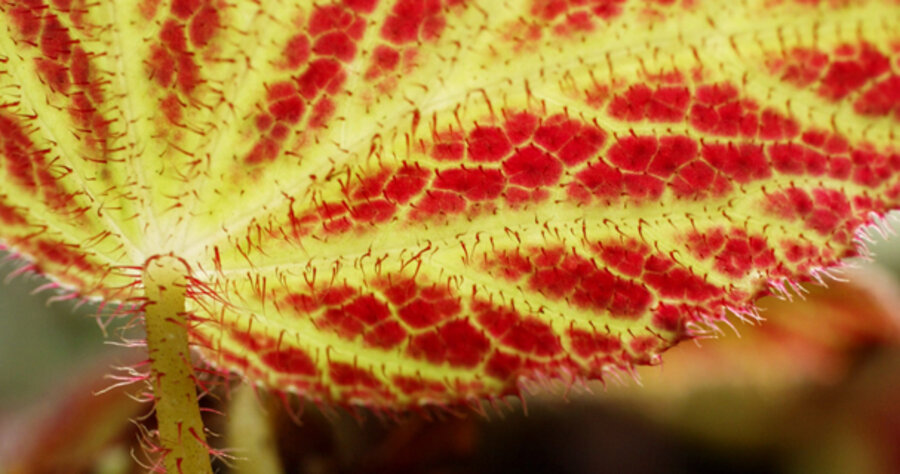The versatile begonia puts its best leaf forward
Loading...
| DES MOINES, IOWA
I hate to admit it, but I have a plant prejudice: I am a former begonia hater. Perhaps my original distaste for the plants came from the years I worked as the admissions gate attendant at Planting Fields Arboretum in Oyster Bay, N.Y.
Late each spring, the large beds in front and behind the booth were planted with impatiens and begonias – the most common annuals for semi-shade. They were typical bedding begonias, growing less than a foot tall, with green or bronze leaves and white or pink flowers. One day, after hearing me sound off, the curator of the begonia collection in the main greenhouse challenged me that he could change my mind about begonias.
He proudly showed off his 200-plus plants. I was amazed at the variety of leaf textures and shapes – from tiny and hairy to huge and smooth, from rounded to serrated, and from flat to crinkled. He gave me a rooted leaf cutting that grew into a gorgeous plant, which later moved with me to Iowa.
Although bedding begonias are considered annuals, all begonias are tropical perennials that can live for years indoors (outdoors in USDA plant hardiness zones 10 and 11). Rhizomatous and tuberous begonias need to go dormant in the winter.
The American Begonia Society divides begonia into different horticultural classes: canelike (tall, bamboo-like stems that bear large, airy clusters of flowers, also known as "angel wings"); rex (considered to be the "kings" of begonias with amazingly colorful leaves – streaked, spotted, splotched, or bordered by many colors, easiest to grow from cuttings); rhizomatous (clouds of flowers rising above the leaves year-round, easy to grow); semperflorens (the commonly grown begonia – the bedding or "wax" begonia); shrublike (upright, branching stems); trailing-scandent (like vines, they grow up or trail down, depending on how they are planted, great for hanging baskets); and tuberous, (with large, showy blossoms).
There are many begonias from which to choose, and new varieties arrive every year. Rex and tuberous begonias are more challenging to grow for the beginner and are more finicky about growing conditions, so start off with other types. These are my picks for some of the best to grow:
• Benitochiba: Magnificent palmate, metallic rosy-red leaves. Tolerates lower humidity. Well-branched with an upright stem, pink flowers borne on 24-inch stems. Height: about 24 inches. Shrublike.
• Black Raspberry: Pebbly textured leaves – reddish-green with red veins above, red below. Pink blossoms. Height: 10 to 15 inches. Rhizomatous.
• Bubbles: Fanciful, eye-catching dark-green angel-wing leaves dotted with white. Reddish-pink flowers with a delightful apple blossom scent (when grown in high humidity and sun). Height: 12 to 24 inches. Canelike.
• Cathedral (Stained Glass begonia): Awe-inspiring when filtered light shines through the leaves, giving the impression of red and green "windows" on the unique ruffled leaves. Flowers: 12-inch spikes of ivory-pink. Height: 18 to 20 inches. Rhizomatous.
• Cowardly Lion: Coppery-gold leaves with deeply colored veins. Hairy stems. Showy white blooms. Height: 6 to 12 inches. Rhizomatous.
• Cracklin' Rosie: Amazing plant with deep-green tops of angel-wing leaves, covered with dainty pale pink dots; undersides are rich maroon. Infrequent rosy-red blossoms. Height: 36 to 42 inches. Canelike.
• Dragon Wing Pink: Spectacular in hanging baskets. Deep-green "angel wings" with nonstop panicles of pink blooms. Height: 2 to 18 inches. (Note: It is unlawful to propagate this trademarked variety.) Canelike.
• Joe Hayden: A favorite with compact, glossy star-shaped leaves – deep olive above and reddish brown below. Pink blossoms. Height: 15 to 30 inches. Rhizomatous.
• Looking Glass: Striking, ruffle-edged leaves, shiny silver with green veins above, red below. Height: 18 to 24 inches. Canelike.
• Marmaduke: Attention-grabbing, bubbly textured leaves splashed with copper and gold. Tall sprays of pink flowers. Height: 12 to 15 inches. Rhizomatous.
• Orococo: Absolute showstopper with slightly pebbled, coppery green-gold leaves edged in rust borne on burgundy stems. Perfect for hanging baskets. Height: 10 to 12 inches. Trailing.
• River Nile: Eye-catching black-to-reddish-brown-edged chartreuse leaves with ruffled edges and swirled centers. Pink blossoms borne on 27-inch spikes. Height: 20 inches. Rhizomatous.
Once you start growing begonias, you can easily become hooked. One pot can become a tabletop full of plants. Remember which ones your friends admire, and you can surprise them with their own plant.
Before you know it, you may be trading cuttings with other enthusiasts. In the meantime, you'll be adding wonderful splashes of color and texture to your home in winter (and you can move them outdoors in summer).
Growing Tips
For the best possible begonias, follow these guidelines:
• Grow indoors year-round or in summer outdoors in containers.
• Give filtered light or partial shade; no direct sun.
• Use rich, well-drained soil.
• Let soil dry slightly between waterings.
• Place pots on a tray of gravel with water to provide humidity in winter.
• Keep temperatures above 60 degrees F. indoors.
• Feed from March through October.
Simple propagation techniques
Clear, plastic 35-mm film canisters make excellent containers for growing leaf cuttings, as the rim of the container supports the leaf in an upright position.
• Cut leaf off plant; be sure leaf has one inch of stem.
• Trim leaf so it is no larger than 2 inches in diameter.
• Put cutting in a film canister or other small container. Add water to cover bottom one-quarter of stem.
• Put cutting under grow lights. Mist daily and maintain water level. Roots should form in about three weeks.
• After four weeks, transplant rooted cutting into lightly moistened potting soil.
Begonia resources
The American Begonia Society San Francisco
www.begonias.org
Glasshouse Works
Stewart, Ohio
www.glasshouseworks.com
Kartuz Greenhouses
Vista, Calif.
www.kartuz.com
Lauray of Salisbury
Salisbury, Conn.
www.lauray.com
Logee's Greenhouses
Danielson, Conn.
www.logees.com
White Flower Farm
Litchfield, Conn.
www.whiteflowerfarm.com





